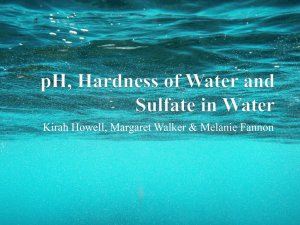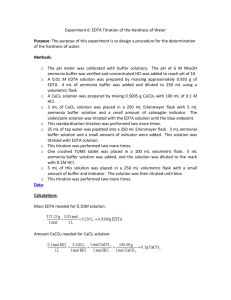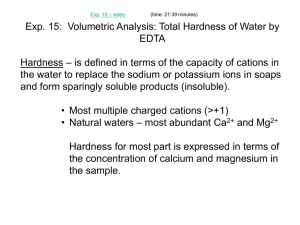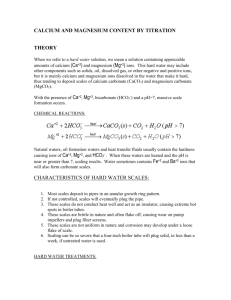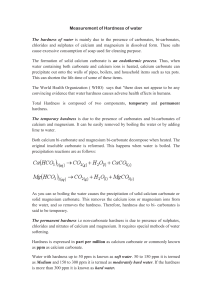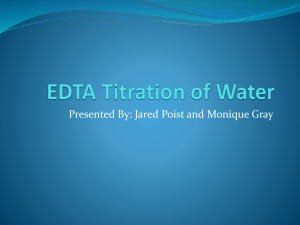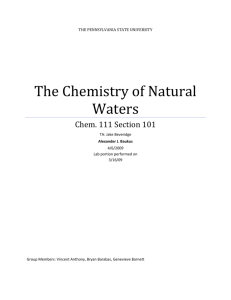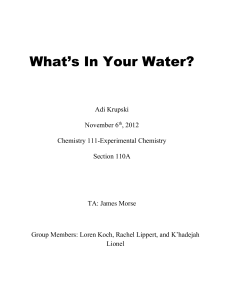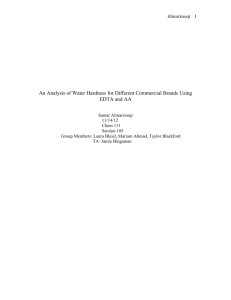Chemistry of Natural Waters report
advertisement
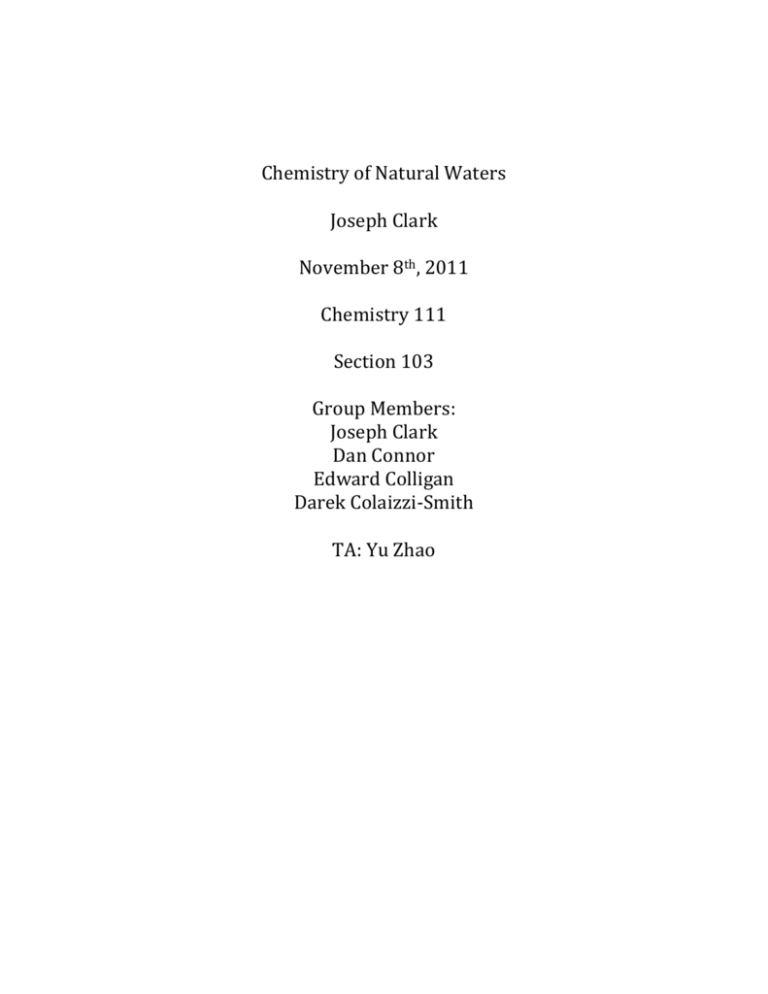
Chemistry of Natural Waters Joseph Clark November 8th, 2011 Chemistry 111 Section 103 Group Members: Joseph Clark Dan Connor Edward Colligan Darek Colaizzi-Smith TA: Yu Zhao Introduction: Water, three simple atoms making a molecule that the world revolves around. Within nature though, there can be other ions, impurities, and pollution changing how the water will act in certain situations. When water moves in the water table through soil and rocks, the result is the dissolving of small amounts of minerals such as magnesium and calcium that stay in the water as ions. When high levels of magnesium and/or calcium ions are present the water is denoted as “hard” water.1 The concern for water hardness is the functionality of the water in machines, pipes, and water using appliances. The water denoted as “hard” can cause buildups of calcium and magnesium deposits (lime scale deposits). These deposits and buildups can clog pipes and reduce the efficiency of these appliances raising energy bills, sometimes up to 25 percent.2 As with industry, the expense of the removal of the deposits is very expensive and even sometimes impossible resulting in the replacement of pipes. The deposits can even effect the structural integrity of the metal apparatuses by corrosion of their walls.3 Since the effects of water hardness are of such magnitude there as been methods devised to combat the hard water. First there have been scales developed in the measurement of the water hardness. On a scale of parts per million(ppm) of calcium and magnesium ions in the water solution. The classifications go by a range of soft to very hard with values of less than 17.1 ppm to over 180 ppm. Hardness can also be measured in grains per gallon.1 These to different types of values can be interconverted, which will be addressed later in the report. Below is a table outlining the concepts just addressed of water hardness. Water Hardness Scale Grains Per Gallon Milligrams Per Liter (mg/L)or Parts Per Million (ppm) Classification less than 1.0 less than 17.1 Soft 1.0 - 3.5 17.1 - 60 Slightly Hard 3.5 - 7.0 60 - 120 Moderately Hard 7.0 - 10.5 120 - 180 Hard over 10.5 over 180 Very Hard To determine the water hardness of our water samples we used two methods, AA (atomic absorption) and EDTA titration. EDTA titration is a process in which the sample at hand has its pH adjusted to 10, by means of an NH3/NH4 buffer, and is then an EBT indicator, a blue solution, is added to the water sample. If the sample contains Mg2+ ions they will react with the indicator to produce a red color. EDTA is then added to the sample. The EDTA first reacts with the Ca2+ ions creating a colorless chelate and then when all of the Ca2+ ions are used the EDTA begins to react with the magnesium to produce more colorless chelate but when all of the magnesium ions are removed from the blue indicator, the color returns to a blue. The amount of EDTA used to return the solution to a blue color is measured and from this you can determine the ppm of the calcium and magnesium ions present in your water sample.3 The other method is an atomic absorption spectrophotometry (AA). This method of hardness measurement is based on the fact that each specific atom of the periodic table has unique individual electron energy levels. There needs to be a certain wavelength of light to excite the electrons present in these atoms. So when using AA, there is a beam of monochromatic light having the same energy change needed to excite the electrons is shot through a portion of the water sample after is has been completely ionized by a flame reaching temperatures of approximately 2300 degrees Celsius. The light is only absorbed by the ions that match it so a separate test has to be conducted for both a calcium ion concentration and a magnesium concentration.3 The amount of light that is absorbed is measured and the absorbance value is then converted into a ppm concentration by way of several calculations that will be gone over later in this report. Along with methods of determining the hardness of the water there have been many treatment methods made to help soften the water. One method would be adding lime or washing soda to precipitate the Ca2+ and Mg2+ ions out of the solution into insoluble salts. Then the precipitated compounds are taken out by ways of filtration or just being settled out then the water is sent through a boiler or an evaporator.3 Another way to soften the water would be by ion exchange. This is done by percolated through ion exchange material where the monovalent cations (like Na+ and H+) present in the resin are exchanged for the divalent magnesium and calcium ions. This pulls the calcium and magnesium out of the solution and is much more effective than the washing soda method of softening, but is also much more expensive. In my groups experiment we tested 4 different water sources; rainwater, lake water from Bald Eagle State Park, distilled water, and tap water from Penn State University Park. My hypothesis was that the distilled water would be the softest of the samples if it is truly distilled it should not have a hardness at all. Since it will have little to no hardness I will be using this as a baseline to compare to the rainwater sample, which should be the next hardest sample. The next hardest, the third hardest, sample would be the lake water. This hardness would be due to the tributaries of the lake (mostly creeks and streams) from which the water is originally from would be percolated down through mountains surrounding the lake picking up magnesium and calcium ions along the way. The tap water will most likely be the hardest of the four samples. The water of State College, PA tends to be hard to very hard ranging from 120ppm to 190ppm.4 Procedure: The full procedure can be obtained from PSU Chemtrek3 pages 10-15 to 10-22. I followed the procedure exactly no changes necessary. The procedure began by visually examining the water sample noting characteristics such as cloudiness and visible particles. If particles were present filtration is necessary and if not this step was skipped. Then two pipets were filled with the filtered water sample then placed in a 24-well tray as a holder to keep hands free to operate the AA machine. The samples were run through the AA machine twice, once for the calcium ions and again for the concentration of the magnesium ions. The experiment moved on to a Total Dissolved Solids (TDS) determination. A piece of foil is obtained and drops of the water sample along with a drop of 1 x 10-3M Ca2+ solution were placed on it. This foil was then heated on a hot plate until the water was evaporated. Them the foil was removed and observations of the contents on top of the aluminum foil were taken down such as amounts of the white solid residues. Comparisons between both the water sample and the Ca2+ solution were made. The next section was the divalent cation analysis by EDTA titration. Note: all apparatuses used were cleaned with distilled water to avoid contamination by past water samples or other materials that were being used by them. A 1x12 well had 1 drop of eriochrome black T(EBT) placed in the first three wells. The a NH3/NH4 buffer was added to only wells two and three and stirred noting the color. Then a drop of 10-3 M Mg2+ solution was added to well three and stirred, recording all changes. Wells two and three will now be a baseline of the color for the titrations done involving the EDTA. A new 1 by 12 well is obtained and a serial titration of the water sample is going to be done. This is done by adding one drop of EBT into each well, one drop of NH3/NH4/MgEDTA buffer into each well and then using the EDTA solution you titrate serially, as in, add 1 drop to the first well, two drops to the second well, and so on until you are adding 12 drops of the EDTA into the 12th well. Afterwards a progression of the drops of EDTA is visible showing when the color change from red back to blue occurred. This color change is considered the end point even though the EDTA is in excess, so the blue well is slightly past the actual end point. Then the concentration of the solution is calculated based on the number of drops of EDTA is took to change the color of the solution. This is just practice the next section involves actually calculating your water samples hardness. Using the same steps mentioned above duplicate the process but use the water sample instead of the 1x10-3M Ca2+ solution. Depending on the number of drops it took to change the color of the solution calculate the hardness in molarity, ppm and grains per gallon. Also calculations for the precision of measurements using this method were calculated. The next step was treating the water sample with a commercial waterconditioning agent. The sample was placed in a vial with 20mg of the commercial softener used which was Arm and Hammer. The powder was dissolved then another serial titration using the EDTA was performed using the same steps before and the results were compared with the original serial titration of the untreated water sample. Divalent cation removal by ion exchange was the next method of water softening used. A small amount of cation exchange resin was added to a vial containing the water sample and shaken gently. The treated sample was then removed from the vial avoiding also sucking up the resin beads. The treated sample was tested by a piece of pH paper and then also processed by an EDTA titration and compared with the other two titration results already preformed. The last section went over calculations involving the conversion of titration values to ppm and grains per gallon to show the water hardness result of each titration. Results: The results for the four members of our lab group are as follows, rainwater6, lake water8, distilled5, tap water7 The above table shows the values for the AA determination, the EDTA results, and the EDTA results after the water was treated by the softening methods of both the soda and the ion exchange. Calcium AA Calibration Graph 60 50 40 Series1 30 Linear (Series1) 20 10 y = 95.827x - 1.3086 0 0 0.1 0.2 0.3 0.4 0.5 0.6 The x-axis denotes the absorbance value and y-axis denotes the concentration Magnesium AA Calibration Graph 35 30 25 20 Series1 15 Linear (Series1) 10 5 y = 63.797x - 1.0655 0 -5 0 0.1 0.2 0.3 0.4 0.5 0.6 The x-axis denotes the absorbance values and the y-axis denotes the concentration Calculations AA calculations From Graphs Mg Concentration: y = 63.797(.2325) – 1.0655 = 13.767 Ca Concentration: y = 95.827(.32) -1.3086 = 29.356 Mg: 13.767ppm Mg2+ x [(100gCaCO3/1mole)/(24.3g Mg2+/1mole)] = 56.654 ppm CaCO3 or hardness Ca: 29.356ppm Ca2+ x [(100gCaCO3/1mole)/(40.0g Ca2+/1mole)] = 73.39 ppm CaCO3 or hardness 56.654 ppm hardness + 73.39 ppm hardness = 130.044 total ppm hardness EDTA Results PPM 8 drops of EDTA x 2.00 x 10-4M = 1.6 x 10-3moles of calcium (1.6 x 10-3 moles of CaCO3/1 Liter of solution) x (100.0g CaCOs/1 mole CaCO3) x (1000mg CaCO3/1 g) = 160mg CaCO3/ 1 Liter of solution or 160ppm Grains per Gallon 160ppm x (1 grain per gallon/ 17.1ppm) = 9.357 grains per gallon Equations 1 grain of CaCO3/1 gallon water = 17.1ppm Discussion: The results that our group got were a hardness value, from the AA determination, of 9.18 ppm for the rain water, 130ppm for the lake water, 8.26 for the distilled water, and 67.4 ppm for the tap water. This is almost exactly my hypothesis. The distilled water was the lowest ppm concentration, even though it having a concentration was surprising to me. The next highest ppm concentration was the rainwater which makes sense since rainwater is naturally soft.9 The hypothesis was wrong with the tap water and the lake water. The lake water ended up being harder than the tap water by a significant margin. The values tended to be higher with the EDTA titration in comparison with the AA values. I think this can be connected to the easy inaccuracy of the EDTA titration of purposely going over the amount of EDTA needed to chelate the ions since it needs to be in excess to change the color of the solution. Also, the difference of one well can change the ppm value obtained by 20 ppm, which is a very large difference. This may be one of the reasons for the 30 ppm difference in the lake water between the AA method and the EDTA titration. Also, the AA machine is not 100% accurate it also has flaws; this is where the check standard came in. The check standard for each value for the AA machine was checked and each number was slightly off but not enough to make a colossal difference. As with the different softening techniques, the ion exchange was definitively a much stronger softener than the softening soda. The value for the lake water sample after the softening soda was 120 but after the ion exchange resin it was all the way down to 40 ppm, a difference of being slightly hard/hard and soft. The values for tap water were very surprising since the normal range for State College water is between 120ppm and 190ppm, a hard to very hard rating,4 The lake water seemed to be well fit for a high range ppm due to the contents of the water table in Central Pennsylvania. In the ground water table there are abundant amounts of limestone (CaCO3) and dolomite (CaMg(CO3)2) contributing to the high levels of Ca2+ ions and Mg2+ ions making the water much harder as it is percolated downward though the rocks.10 Limestone in Pennsylvania, especially near state college, is in huge deposits beneath the surface.11 Spanning in between the mountains, the water travels through this limestone to keep picking up Ca2+ ions creating harder and harder water. Conclusions The overall findings was that when the water has greater time to percolate through the Limestone and Dolomite deposits in the water table the hardness is much greater than if the water is taken from the rain, which has very insignificant amount of calcium and magnesium in the forms of divalent cations. The hardness of the distilled water and the rainwater were close to identical only varying by a few ppm. This shows how soft rainwater truly is. The tap water should have been harder according to the State College Borough Water Authority.4 The value of 67.4 ppm does not fall close to the range of 120ppm to 190ppm.4 In reference to my hypothesis I was mistaken by ranking tap water harder the lake water. The lake water has tributaries of very hard water since they are flowing down through the mountains around it, these mountains containing large deposits of limestone and dolomite. Overall the values attained by EDTA titration and AA determination, were not too surprising. The water softening agents both did a good job of softening the water, but the ion-exchange resin beads did a better job bringing the hardness from a value of 160ppm for the lake water to only 40ppm after treatment. Water hardness is a very precise science and the understanding of which will help offset its affects in industry, homes, and our drinking water.

